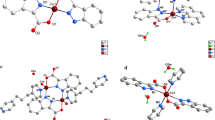Abstract
Copper(I) π-complexes with 2-allylamino-5-phenyl-1,3,4-thiadiazole (C11H11N3S) of the composition [CuCl(C11H11N3S)] (1) and [Cu(C11H11N3S)(H2O)(CH3CN)]2SiF6·2CH3CN (2) are obtained by alternating current electrochemical synthesis and studied by single crystal X-ray diffraction. In both structures, the L molecule coordinates to the Cu(I) atom by the C=C bond of the allyl group and the N3 atom of the 1,3,4-thiadiazole core. In 1, the coordination environment of the metal atom is completed to trigonal by one terminal halogen atom, and in 2, it is completed to the tetrahedral environment by the acetonitrile N atom and the O atom of a water molecule. The bridging function of the organic ligand in 1 leads to the formation of coordination chains {CuCl(C11H11N3S)}∞, whereas cationic π-complex 2 is formed from monomeric {Cu(C11H11N3S)(H2O)(CH3CN)}+ cations and SiF 2−6 anions. A branched system of O–H⋯F, O–H⋯N, and N–H⋯F hydrogen bonds in compound 2 forms hydrogen-bonded layers.
Similar content being viewed by others
References
Y. Hu, C.-Y. Li, X.-M. Wang, et al., Chem. Rev., 114, 5572–5610 (2014).
A. K. Jain, S. Sharma, A. Vaidya, et al., Chem. Biol. Drug. Des., 81, 557–576 (2013).
A. S. Shawali, J. Adv. Res., 5, 1 (2014).
Y. Slyvka, E. Goreshnik, O. Pavlyuk, and M. Mys′kiv, Cent. Eur. J. Chem., 11, 1875–1901 (2013).
E. A. Goreshnik, Yu. I. Slyvka, and M. G. Mys′kiv, Inorg. Chim. Acta, 377, 177–180 (2011).
E. A. Goreshnik, A. A. Vakulka, Yu. I. Slyvka, and M. G. Mys′kiv, J. Organomet. Chem., 710, 1–5 (2012).
R. G. Pearson, J. Am. Chem. Soc., 85, 3533–3539 (1963).
B. Ardan, Yu. Slyvka, E. Goreshnik, and M. Mys′kiv, Acta. Chim. Slov., 60, 484–490 (2013).
Yu. Slyvka, N. Pokhodylo, R. Savka, et al., Chem. Met. Alloys, 2, 130–137 (2009).
Yu. Slyvka, N. Pokhodylo, R. Savka, et al., Chem. Met. Alloys, 3, 201–207 (2010).
G. Pulvermacher, Chem. Ber., 27, 613–630 (1894).
B. M. Mykhalichko and M. G. Mys'kiv, Ukranian Patent No. UA 25450, A/Bull., No. 6 (1998).
G. M. Sheldrick, SHELXS-97, SHELXL-97, Programs for the Solution and Refinement of Crystal Structures, University of Göttingen, Germany (1997).
Y. Deng, J. Liu, Q. Zhang, et al., Inorg. Chem. Commun., 11, 433–437 (2008).
E. A. Goreshnik, G. S. Veryasova, D. I. Morozov, and M. G. Mys′kiv, J. Mol. Struct., 1038, 200–205 (2013).
E. A. Goreshnik and M. G. Mys′kiv, Z. Anorg. Allg. Chem., 633, 1723–1726 (2007).
J. Pang, G.-X. Wang, and R.-G. Xiong, Chin. J. Inorg. Chem., 23, 1227–1229 (2007).
A. A. Shkurenko, V. N. Davydov, and M. G. Mys'kiv, Russ. J. Coord. Chem., 32, 270–275 (2006).
E. A. Goreshnik and M. G. Mys′kiv, J. Chem. Cryst., 40, 381–383 (2010).
M. Meot-Ner, Chem. Rev., 112, PR22–PR103 (2012).
T. Steiner, Angew. Chem., Int. Ed., 41, 48–76 (2002).
G. R. Desiraju, Acc. Chem. Res., 35, 565–573 (2002).
Author information
Authors and Affiliations
Corresponding author
Additional information
Original Russian Text © 2015 Yu. I. Slyvka.
Translated from Zhurnal Strukturnoi Khimii, Vol. 56, No. 6, pp. 1171–1176, November–December, 2015.
Rights and permissions
About this article
Cite this article
Slyvka, Y.I. Structural features of CuCl and Cu2SiF6 π-complexes with 2-allylamino-5-phenyl-1,3,4-thiadiazole of the composition [CuCl(C11H11N3S)] and [Cu(C11H11N3S)(H2O)(CH3CN)]2SiF6·2CH3CN. J Struct Chem 56, 1118–1123 (2015). https://doi.org/10.1134/S0022476615060141
Received:
Published:
Issue Date:
DOI: https://doi.org/10.1134/S0022476615060141




